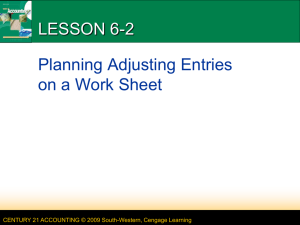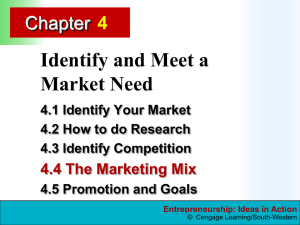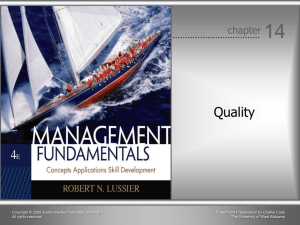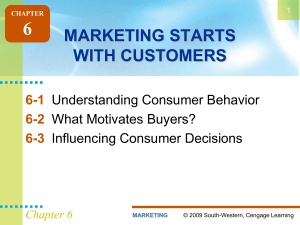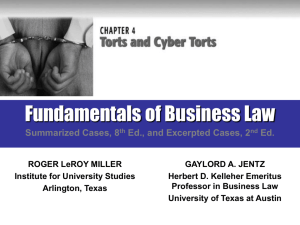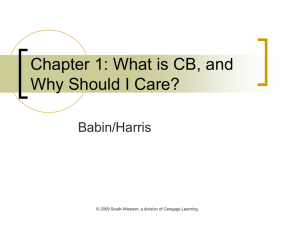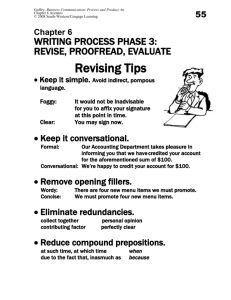Chapter 14
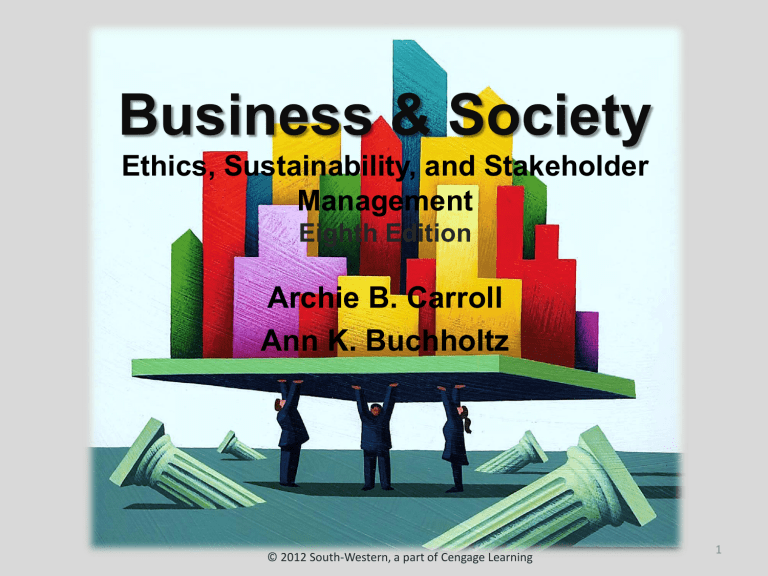
Business & Society
Ethics, Sustainability, and Stakeholder
Management
Eighth Edition
Archie B. Carroll
Ann K. Buchholtz
© 2012 South-Western, a part of Cengage Learning
1
Chapter 14
Consumer
Stakeholders:
Product and
Service Issues
2
© 2012 South-Western, a part of Cengage Learning
Learning Outcomes
1.
Describe and discuss the two major product issues: quality and safety.
2.
Explain the role and functions of the Consumer Product
Safety Commission and the Food and Drug
Administration.
3.
Enumerate and discuss the reasons for concern about product liability, and differentiate strict liability, absolute liability, and market share liability.
4.
Outline business’s responses to consumer stakeholders, including customer service, total quality management
(TQM programs), and Six Sigma.
© 2012 South-Western, a part of Cengage Learning 3
Chapter Outline
•
Two Central Issues: Quality and Safety
•
Consumer Product Safety Commission
•
Food and Drug Administration
• Business’s Response to Consumer Stakeholders
•
Total Quality Management Programs
•
Six Sigma Strategy and Process
•
Summary
•
Key Terms
© 2012 South-Western, a part of Cengage Learning 4
Two Central Issues
Quality
•
Product quality means different things to different people.
•
Service quality usually means that the service was performed as expected and on time.
•
Interest is driven by an increase in family income and intense global competition.
Safety
•
Nearly all consumer products or services entail some small degree of risk.
• Interest about safety is driven by the public’s concern with safety and risk-free products– and business’ responsibility to address this concern.
5
© 2012 South-Western, a part of Cengage Learning
Critical Dimensions of Product Quality
Performance
Perceived
Quality
Features
Aesthetics
Dimensions of
Quality
Reliability
Serviceability Conformance
Durability
© 2012 South-Western, a part of Cengage Learning
6
Ethical Underpinnings of Quality
Contractual Theory
Due Care Theory
Social Costs View
7
© 2012 South-Western, a part of Cengage Learning
The Issue of Safety
•
How safe should a product be made?
Historical Perspective
•
1800s caveat emptor:
• “Let the buyer beware.”
•
1900s caveat vendor:
• “Let the seller take care.”
8
© 2012 South-Western, a part of Cengage Learning
Top Ten List of Safety Principles
1.
Build safety into product design.
2.
Do product safety testing for all foreseeable hazards.
3.
Keep informed about and implement latest developments in product safety.
4.
Educate consumers about product safety.
5.
Track and address products’ safety performance.
6.
Fully investigate product safety incidents.
7.
Report product safety defects promptly.
8.
If a defect occurs, promptly offer a comprehensive recall plan.
9.
Work with the CPSC to make sure your recall is effective.
10.
Learn from mistakes—yours and others’.
9
© 2012 South-Western, a part of Cengage Learning
Consumer Product Injuries
1.
Sports and recreational activities and equipment
2.
Home structures and construction materials
3.
Home furnishings and fixtures
4.
Housewares
5.
Personal use items
6.
Home workshop apparatus, tools, and attachments
7.
Packaging and containers for household products
8.
Home and family maintenance products
9.
Toys
10.
Space heating, cooling, and ventilation equipment
10
© 2012 South-Western, a part of Cengage Learning
Product Liability
Reasons for the concern
•
The sheer number of cases where products resulted in injury, illness, or death and the amount of the financial award.
•
We have become an increasingly litigious society.
•
Rise in the doctrine of strict liability .
•
Anyone in the value chain of a product is liable for harm caused to the user if the product is unreasonably dangerous because of a defective condition.
11
© 2012 South-Western, a part of Cengage Learning
Extensions of the Strict Liability
Rule
Expansion of the strict liability rule is at the heart of the explosion of litigation in the U.S.
•
Absolute liability
•
Is more demanding that strict liability.
•
Market share liability
•
Evolved from delayed manifestation cases where delayed reactions to products appear years after exposure.
12
© 2012 South-Western, a part of Cengage Learning
Other Product Liability Issues
Product tampering and product extortion
Product liability reform (Tort reform)
13
© 2012 South-Western, a part of Cengage Learning
Consumer Product Safety
Commission
•
An independent regulatory agency that was created by the Consumer Product Safety
Act of 1972.
1.
Develops voluntary safety standards with industry
2.
Issues and enforces mandatory standards
3.
Bans consumer products if no feasible standard would protect the public
4.
Obtains the recall of products or arranges repair
5.
Conducts research on potential product hazards
6.
Informs and educates consumers through media, government and private organizations, and by responding to consumer inquiries
14
© 2012 South-Western, a part of Cengage Learning
Consumer Product Safety Commission
(continued)
VOLUNTARY SAFETY STANDARDS
Indoor air quality hazards
Children’s product hazards
Fire/Electrical hazards
Other hazards
Carbon monoxide detectors
Formaldehyde in wood
Bunk beds
Drawstrings on children’s clothing
National Electrical Code
Handheld hair dryers
Automatic garage door openers
Swimming pools
© 2012 South-Western, a part of Cengage Learning
15
Problems Facing the CPSC
Having adequate resources to do the job
Having sufficient staff to address current needs
Being forced to shift priorities
New challenges from a changing world
16
© 2012 South-Western, a part of Cengage Learning
Food and Drug Administration
Food and Drug Administration
•
Grew out of experiments with food safety by Harvey W. Wiley in the late 1800s.
•
The FDA resides within the Health and
Human Services Department.
•
Engages in three categories of activity
Analysis
Surveillance
Correction
17
© 2012 South-Western, a part of Cengage Learning
What does the FDA Do?
The FDA is responsible for
•
Assuring the safety, effectiveness, and security of human and veterinary drugs, vaccines and other biological products, medical devices, the U.S. food supply, cosmetics, dietary supplements, and products that give off radiation.
•
Regulating tobacco products.
•
Advancing the public health by helping to speed product innovations.
•
Helping the public get the accurate, science-based information they need to use medicines and foods to improve their health.
18
© 2012 South-Western, a part of Cengage Learning
Customer Service Programs
•
Building life-long devotion among customers takes serious commitment and hard work.
Companies address customer service through
Money-back guarantees
Warranties
Offices of consumer affairs
Top management must be committed to quality customer service
.
19
© 2012 South-Western, a part of Cengage Learning
Seven Principles of Customer
Service
1.
Keeping your word is where it begins.
2.
Always be honest and tell it like it is.
3.
Always think proactively.
4.
Deal with problems as best you can yourself, never passing the buck.
5.
Do not argue with a customer because it is a lose/lose situation.
6.
Accept your mistakes, learn from them, and do not repeat them.
7.
Consistency is the name of the game for lasting success.
20
© 2012 South-Western, a part of Cengage Learning
Creating a Customer-Oriented
Company
Top-down culture and commitment are essential.
Identify internal champions and uphold them.
Commit resources to the task.
Hire the right people.
Empower employees.
Make customer service training a priority.
21
© 2012 South-Western, a part of Cengage Learning
Total Quality Management
TQM
•
All business functions are blended into an integrated philosophy built around quality, teamwork, productivity, and customer understanding and satisfaction.
•
The customer is the final judge of quality.
22
© 2012 South-Western, a part of Cengage Learning
Total Quality Management
(continued)
TQM emphasizes eight key elements
1.
Ethics
2.
Integrity
3.
Trust
4.
Training
5.
Teamwork
6.
Leadership
7.
Recognition
8.
Communication
The foundation upon which all else is built
23
© 2012 South-Western, a part of Cengage Learning
Business’ Response to Consumers
Define quality in terms of customer expectations
Convert customer expectations to standards and specifications
Realign the organization to ensure quality is achieved
© 2012 South-Western, a part of Cengage Learning
24
Total Quality Management
© 2012 South-Western, a part of Cengage Learning
25
Strengths and Weaknesses of Quality
Definitions
© 2012 South-Western, a part of Cengage Learning
26
Six Sigma Strategy and Process
Six Sigma
•
A general heading under which is grouped a number of strategies, methodologies, and techniques
•
Aims to improve quality and reduce costs.
•
It stresses the importance of customers.
•
Six Sigma level of operation is 3.4 defects per million.
•
Most companies have 6,000 defects per million.
27
© 2012 South-Western, a part of Cengage Learning
Consumer-Stakeholder Satisfaction
Model
Product Quality and Safety
Continued
Purchases by
Consumers
Consumer
Satisfaction
Firm
Profitability
Service Quality and Safety
Firm
Reputation
© 2012 South-Western, a part of Cengage Learning
28
Key Terms
•
Absolute liability
•
Consumer Product
Safety Act of 2008
•
Consumer Product
Safety Commission
•
Consumer stakeholder satisfaction model
•
Contractual theory
•
Delayed manifestation cases
•
Due care theory
•
Food and Drug
Administration
•
Market share liability
•
Product liability reform
•
Six Sigma
•
Social costs view
•
Strict liability
•
Tort reform
•
Total Quality
Management
29
© 2012 South-Western, a part of Cengage Learning
